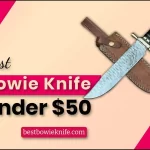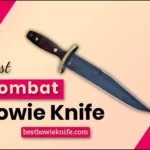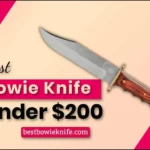To make a Bowie knife, users need to follow numerous steps to produce a high-quality utensil. All these steps have significant importance in creating highly versatile, durable, and compact Bowie knives.
Here in this article, we’ll share the best 12 steps that we have concluded to make a perfect-quality Bowie knife. Moreover, we will also discuss their composition from certain other materials. So, be sure to read all about these given steps till the end.
How to make a Bowie knife?
Here are the best and most versatile steps that we discovered in making these special Bowie knives. In addition, you can easily use all of these techniques for making combat, Skinning, and other homemade knives.
Before we go into any further details, we would like to recommend you read out our previous articles such as How to date a case Bowie knife? And other Bowie knife-related articles and blogs on this same website.
So, let’s start with these amazing steps to create a Bowie knife with the best quality materials and techniques.
1. Choose the Right Materials
To create a Bowie knife, you have to pick the best materials for the blades and handles of these knives. High carbon steel blades, such as 1095 or 5160, are common choices for Bowie knives due to their edge retention, durability, and ease of sharpening.
A stainless steel knife resists rust, but cannot be sharpened, while a Damascus knife has an unusual pattern and is used for high-end knives. Wood, bone, or synthetic materials, such as G10, are typically used for the handles of Bowie knives.
Moreover, think about durability, comfort, and grip when selecting a handle material. To prevent cracking and discoloration over time, some handle materials, such as bone or ivory, may require special care.
2. Plan the Designs
A Bowie knife’s design is influenced by several elements, such as its length, thickness, curve, and handle shape and style. The first step is to determine what the knife will be used for. Camping or outdoor activities, for example, may require a larger, curved blade.
Sketch out the design once you know the overall size and shape of the blade. Pay attention to how the blade and handle balance, as well as how the handle itself is designed.
Become familiar with traditional Bowie knife designs by researching them, but do not be afraid to add your twist. Additionally, you can add details to the knife, such as etching or a decorative guard. You can use your design as a guide when creating the knife after you’re satisfied with it.
3. Cut & Forge the Blades
Bowie’s knives require specialized tools and equipment to cut and forge their blades. Attempting to make a knife on your own can be a dangerous and complex process, and we recommend seeking professional guidance and training first.
A blade blank, formed from a rectangular piece of steel, is the first step in cutting and forging a blade. The blade blank is cut to the desired size using a power hacksaw or bandsaw, and then heated and shaped using a forge, anvil, and hammer.
Blade thickness, curve, and shape are repeatedly adjusted by heating and shaping. Additionally, forging hardens and strengthens steel. In the end, Heat-treating and grinding refine the blade’s shape and edge after forging.
4. Heat Treating
A blade’s hardness, toughness, and overall performance are greatly affected by heat treatment. Heat treatment changes the steel’s microstructure, therefore altering its physical properties.
First, a blade must be heated to a specific temperature in a furnace or forge. Steels are typically heated between 1,500°F and 2,500°F, depending on their type. An oil bath, water bath, or another medium can be used to quench a blade. Rapid cooling hardens the steel and enhances its durability.
To increase the toughness and reduce brittleness, the blade is tempered after quenching. Hardness and toughness are balanced by tempering at a lower temperature than the initial heat treatment.
5. Grinding the Blades
The process of grinding a blade creates its final shape and prepares it for use. Heat-treated blades are ground coarsely using grinding wheels or belt sanders after they have been heat-treated.
The shape and edge of the blade can be refined further using a finer grinding wheel or belt by using a finer grinding wheel or belt. The final shape and sharpness of the blade are determined by precision and patience at this stage.
Additionally, an edge is ground to a desired angle and bevel, which affects the blade’s performance and cutting ability. Follow all these steps, and you can easily grind the blades of your bowie knives.
6. Create the Handles
It is important to choose the right materials and carefully shape and attach them to the blade when creating the handle for a Bowie knife. Good grip, durability, and long-lasting are all qualities of a good handle.
In addition to wood, bones, and horn, synthetic materials such as Micarta and G10 can also be used for knife handles. After selecting the material, it is shaped to fit the blade and the hand of the user. Lathes, carving machines, and sanding machines can all be used to achieve this.
In the full tang construction, the blade extends through the handle and is attached to the handle by screws, and pins, or a full tang construction. A knife should have a secure handle attached to a blade, as this will ensure safety.
7. Finish the Handles
Bowie’s knives are finished with smooth surfaces and beautiful finishes in the final step of the manufacturing process. A handle can be finished in several ways, including sanding, polishing, oiling, and waxing.
From coarse grit to fine grit sandpaper should be used when sanding. A smooth surface is created by removing any rough spots. Then you can polish by hand using a soft cloth or by using a polishing wheel. It is also possible to enhance the appearance of the handle by oiling or waxing it.
It is important to ensure that the finish is even and smooth and that there are no cracks or blemishes on the handle. Attaching the handle to the blade completes the process and the knife is ready for use.
8. Apply the Protective Coatings
Protecting a Bowie knife with a protective coating helps keep it from corroding, and enhances its appearance. The material of the blade and desired results will determine the coating type.
The blade can be coated with oil to protect it from moisture and rust. An oily cloth is used to apply the oil to the blade. Excess oil is then buffed off. Additionally, wax coatings add shine and smoothness to blades while providing a protective barrier.
Lacquer and epoxy are also good options for protecting and shining the blade. Choosing a coating that provides the desired level of protection and appearance is important for the blade material. Maintaining the effectiveness of the coating requires regular reapplication.
9. Sharpen the Knives
Maintaining the performance and cutting ability of a Bowie knife requires sharpening. Honing steels, sharpening stones, and electric sharpeners are all methods of sharpening knives.
A sharpening stone’s grit determines how smooth or coarse the edge is, and coarser stones are used for dull blades. Stones are used to sharpening knives by holding them at an angle and moving them back and forth. Rather than sharpening knives, honing steel realigns dull or bent edges.
For those who don’t know how to use sharpening stones, electric sharpeners use rotating grinding wheels to sharpen the blade. The correct sharpening method and proper technique are important to avoid damaging the blade when sharpening a knife.
10. Test the Knives
To ensure that a Bowie knife performs as intended, it must be tested before manufacturing. In addition to cutting tests and durability tests, safety tests are also performed on knives.
To evaluate the cutting ability of a blade, various materials such as paper, cardboard, and rope can be sliced through. To test a blade’s durability, chop, and pry actions can be used.
Check the handle and blade for cracks or other signs of damage, and test the handle for stability and grip. To ensure safety and performance, knives must undergo a thorough testing process.
11. Other Customization
Making a Bowie knife unique to the owner can be achieved by customizing it. Adding decorative elements, engraving, and customizing the handle are just a few options for customizing a knife.
It is possible to add a name, initials, or special message to a blade or handle when engraving it. To add a personal touch, decorative elements can be etched or inlaid into the blade or handle.
You can customize the handle by using wood, bone, or synthetic materials, adding grips, or adding decorative pins. To ensure the safety and functionality of the knife, choose customization options that are suitable for its specific function. One-of-a-kind Bowie knives can be cherished for years to come.
12. Store the Knives
Maintaining the condition and safety of a Bowie knife requires proper storage. In addition to knife blocks, magnetic strips, and sheaths, there are other methods for storing knives.
Knife blocks provide a secure place for storing knives, and they also protect them from damage. Choosing a magnetic strip that is strong enough to hold the knife securely and avoid contact with other knives is important when mounting a knife on the wall.
In addition to protecting the blade, sheaths can be used to carry knives. A knife should be stored in a way that will not damage its handle or blade. Maintaining a Bowie knife in top condition can extend its life and keep it in top condition.
How do you make a Bowie Knife from other Materials?
To make a bowie knife from a file, without using a forge, from a leaf spring, Farrier rasp, from scrap, and all other materials. It is essential to follow the given below steps accurately.
- Make sure you have a file, ideally, one made of high-carbon steel, or alternative materials like paper, farrier, or leaf springs
- Files should be heat treated so that the blades are as hard as possible
- With the help of a belt grinder or a bench grinder, grind the blade until it is the desired shape
- A file or sandpaper can be used to finish the edge by hand
- The edge can be hardened by heating it to a high temperature and quenching it in oil or water
- The blade can be tempered by cooling slowly after it has been heated to a lower temperature to reduce brittleness
- A smooth blade can be achieved by sanding or polishing it
- A tang, screws, or adhesive can be used to connect the handle to the blade
How to make a Wooden Bowie Knife?
Here are some of the best steps that we have discovered which are quite simple to make a wooden Bowie knife. Make sure to follow the same steps for easy manufacturing of these wooden-based knives.
- Use sawing tools, sandpaper, and carving tools to shape hardwood into a handle shape and size
- By applying screws, epoxy, or a tang to the handle, you can secure a piece of metal, such as a blade from an old saw
- A metal blade must be shaped and sharpened to the desired edge and shape
- Make the handle and blade as smooth as possible with sandpaper and protect them with oil or sealant
How to make a Sheath for Bowie Knives?
Here take a look at the best steps that you can easily use to make a sheath for these special tactical, d guard, and homemade Bowie knives.
- Make the body of the sheath out of materials such as leather, plastic, Kydex, or suede
- Aim to cut the material to the blade’s size and shape, taking the blade’s size and shape into consideration
- Using the contours of the blade as a guide, bend the material into the shape you desire
- The edges of the sheath should be secured together with screws, snaps, or adhesives
- If necessary, add a belt loop or another attachment method to the sheath to allow it to be attached to a belt or other surface
- After the sheath has been sanded, stained, or painted, it is ready to be used
How do you make a Cardboard & Paper Bowie Knife?
Last but not the least, you may also like this list of the best steps that we have discovered to make a Bowie knife from paper and cardboard.
- For the sheath’s body, choose materials such as leather, plastic, Kydex, or suede
- Ensure that the blade size and shape are taken into account when cutting the material
- Using the blade’s contours as a guide, bend the material to its proper shape
- You can attach the edges of the sheath with screws, snaps, or adhesive
- If necessary, add a belt loop or another attachment method to the sheath to allow it to be attached to a belt or other surface
- Depending on your preference, sand, stain, or paint the sheath
Read more: https://bestbowieknife.com/how-to-make-a-bowie-knife-sheath/
What does a Bowie knife look like?
Wood, bone, or metal handles can be found on Bowie knives, which have curved blades with pointed tips. There is usually a single or double edge to the blade and the length is usually between 6 and 15 inches.
Handle guards and hilts serve as hand protection. A variety of cutting and thrusting tasks can be accomplished using the overall shape. The blade or handle of some Bowie knives may also be engraved or etched with decorative elements.
Frequently Asked Questions:
What makes a knife a Bowie knife?
To make a Bowie knife, one must have a curved, keen point, be double-edged for about two inches [5 cm] of its length, and falls when in use.
Can you make a knife without a forge?
Forging isn’t necessary to make a knife at least for those with novice to intermediate skills. Whether you are just learning to forge blades for the first time or have been practicing for years, hitting hot steel with a forge is fun and exciting.
What kind of blade is a Bowie knife?
Long, double-edged, clip-point blades make up the blades of bowie knives, which are large and fighting-style knives. In addition to skinning games and splitting firewood, these iconic knives can be used to cut the rope and split firewood.
Final Verdict:
To make a Bowie Knife, we have explained the best 12 steps to the users for highly versatile and perfect results. In this article, we have concluded these steps using multiple materials to create a Bowie knife.
Moreover, all the major steps to make a bowie knife sheath from numerous products such as paper and cardboard have also been discussed in this specific article. As we are sure that all information regarding this Bowie knife usage topic can easily be found here.
Last but not least, we hope you’ll find this article interesting and that you’ll be able to make use of the information we have provided here.

![Best Bowie Knife Reviews 2024 | Guide for Everyone [Top 20 Products] Best Bowie Knife Reviews 2024 | Guide for Everyone [Top 20 Products]](https://m.media-amazon.com/images/I/31hfV62McQL._AC_.jpg)




